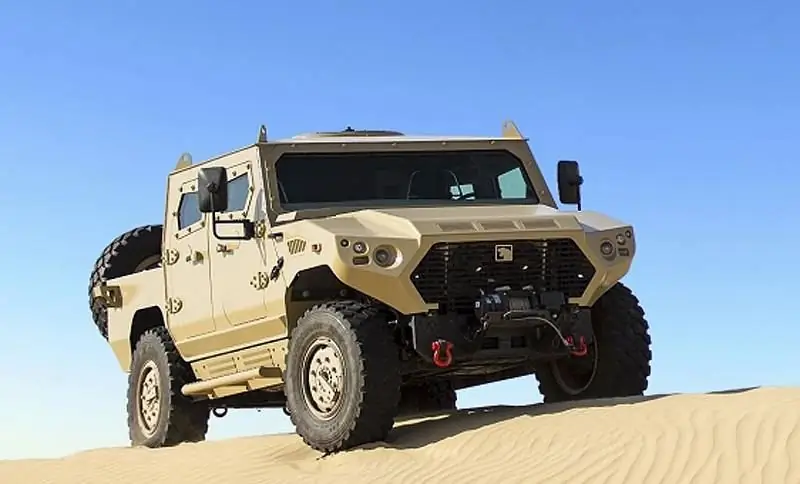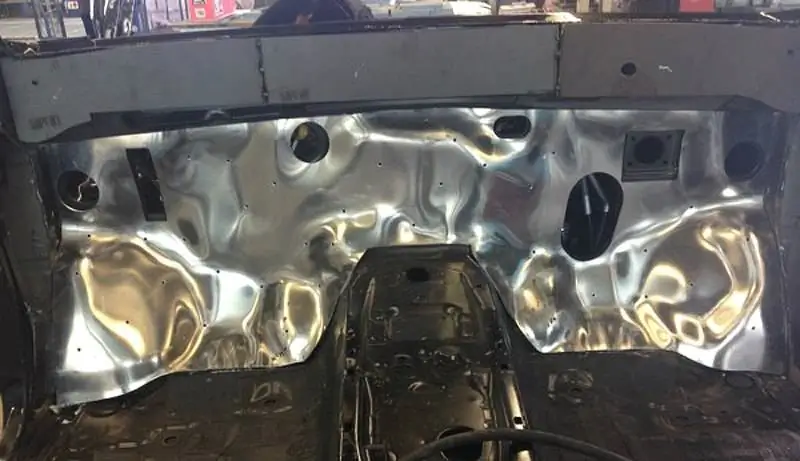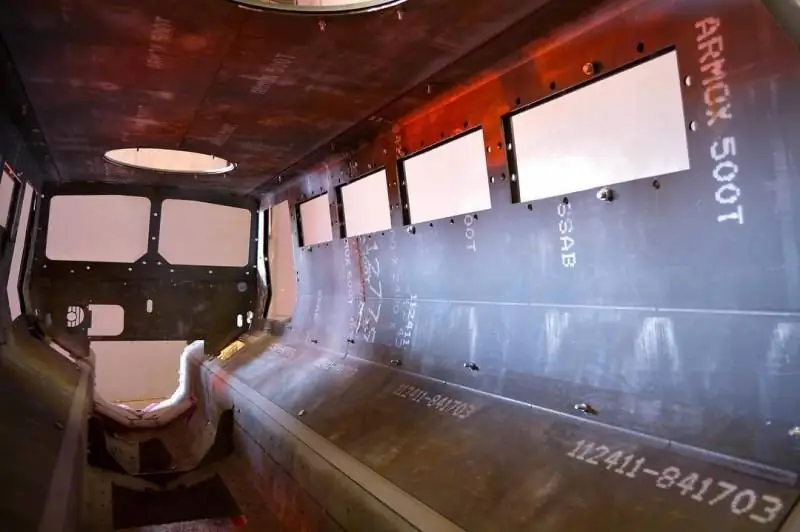- Author Matthew Elmers [email protected].
- Public 2023-12-16 21:49.
- Last modified 2025-01-24 09:17.

Armor is millions of years older than mankind, and it developed primarily to protect against jaws and claws. It is possible that crocodiles and turtles could partly inspire humans to create protective elements. All weapons of kinetic energy, be it a prehistoric club or an armor-piercing projectile, are designed to concentrate a large force in a small area, its task is to penetrate the target and inflict maximum damage on it. Therefore, the job of the armor is to prevent this by deflecting or destroying the attacking means and / or dispersing the impact energy over as large an area as possible in order to minimize any damage to manpower, transport systems and structures that it protects.
Modern armor typically consists of a hard outer layer to stop, deflect, or destroy the projectile, an intermediate layer with a very high "work of destruction", and a viscous inner layer to prevent cracks and splinters.
Steel
Steel, which became the first material widely used in the creation of armored vehicles, is still in demand, despite the emergence of armor based on light alloys of aluminum and titanium, ceramics, composites with a polymer matrix reinforced with glass, aramid and ultra-high molecular weight polyethylene fibers, as well as composite materials with a metal matrix.
Many steel mills, including SSAB, continue to develop high-strength steels for a variety of weight-critical applications such as additional sheathing. Armored steel grade ARM OX 600T, available in thicknesses of 4-20 mm, is available with a guaranteed hardness of 570 to 640 HBW units (abbreviation for Hardness, Brinell, Wolfram; a test in which a tungsten ball of a standard diameter is pressed into a sample of material with a known force, then the diameter of the formed recess is measured; then these parameters are substituted into the formula, which allows you to obtain the number of units of hardness).
SSAB also emphasizes the importance of achieving the right balance of hardness and toughness for penetration and burst protection. Like all steels, ARMOX 600T is composed of iron, carbon and a number of other alloying components including silicon, manganese, phosphorus, sulfur, chromium, nickel, molybdenum, and boron.
There are restrictions on the manufacturing techniques used, especially when it comes to temperature. This steel is not intended for additional heat treatment; if heated above 170 ° C after delivery, SSAB cannot guarantee its properties. Companies that can get around this kind of restriction are likely to attract the close scrutiny of armored vehicle manufacturers.
Another Swedish company, Deform, offers bullet-resistant armor steel hot-formed parts to armored vehicle manufacturers, particularly those looking to improve the protection of commercial / civilian vehicles.
One-piece Deform firewalls are installed in the Nissan PATROL 4x4, the Volkswagen T6 TRANSPORTER minibus, and the Isuzu D-MAX pickup truck, along with a solid floor sheet of the same material. The hot forming process developed by Deform and used in sheet production maintains a hardness of 600HB [HBW].
The company claims that it can restore the properties of all armor steels on the market and at the same time maintain a structurally defined shape, while the resulting parts are far superior to traditional welded and partially overlapping structures. In the method developed by Deform, the sheets are quenched and tempered after hot forging. Thanks to this process, it is possible to obtain three-dimensional shapes that cannot be obtained by cold stamping without the mandatory in such cases "welds that violate the integrity of the critical points."
Deform hot-formed steel sheets have been used on BAE Systems BVS-10 and CV90 and, since the early 1990s, on many Kraus-Maffei Wegmann (KMW) machines. Orders are coming in for the production of three-dimensional armor plates for the LEOPARD 2 tank and several shaped plates for the BOXER and PUMA vehicles, plus for several Rheinmetall vehicles, including again the BOXER, as well as a hatch for the WIESEL vehicle. Deform also works with other protective materials including aluminum, kevlar / aramid and titanium.

Aluminum progress
As for armored vehicles, for the first time aluminum armor was widely used in the manufacture of the M113 armored personnel carrier, which has been produced since 1960. It was an alloy, designated 5083, containing 4.5% magnesium and much smaller amounts of manganese, iron, copper, carbon, zinc, chromium, titanium and others. Although 5083 retains its strength well after welding, it is not a heat treatable alloy. It does not have as good resistance to 7.62mm armor-piercing bullets, but, as official tests confirmed, it stops 14.5mm Soviet-style armor-piercing bullets better than steel, while saving weight and adding the desired strength. For this level of protection, the aluminum sheet is thicker and 9 times stronger than steel with a lower density of 265 r / cm3, which results in a reduction in the weight of the structure.
Armored vehicle manufacturers soon began to request lighter, more ballistically stronger, weldable and heat-treatable aluminum armor, which led to Alcan's development primarily of 7039 and then 7017, both with higher zinc content.
As with steel, stamping and subsequent assembly can negatively affect the protective properties of aluminum. When welding, the heat-affected zones soften, but their strength is partially restored due to hardening during natural aging. The structure of the metal changes in narrow zones near the weld, creating large residual stresses in the event of welding and / or assembly errors. Consequently, manufacturing techniques should minimize them, while the risk of stress corrosion cracking should also be minimized, especially when the machine's design life is expected to be more than three decades.
Stress corrosion cracking is a process of the appearance and growth of cracks in a corrosive environment, which tends to deteriorate as the number of alloying elements increases. The formation of cracks and their subsequent growth occurs as a result of the diffusion of hydrogen along the grain boundaries.
Determination of susceptibility to cracking begins with the extraction of a small amount of electrolyte from the cracks and its analysis. Low strain rate stress corrosion tests are performed to determine how badly a particular alloy has been damaged. Mechanical stretching of two specimens occurs (one in a corrosive environment, and the other in dry air) until they fail, and then the plastic deformation at the site of failure is compared - the more the specimen is stretched to failure, the better.
The resistance to stress corrosion cracking can be improved during processing. For example, according to Total Materia, which calls itself “the world's largest database of materials,” Alcan has improved 7017's performance in accelerated stress corrosion cracking tests by 40 times. The results obtained also make it possible to develop methods of corrosion protection for zones of welded structures, in which it is difficult to avoid residual stresses. Research aimed at improving alloys in order to optimize the electrochemical characteristics of welded joints is ongoing. Work on new heat-treatable alloys focuses on improving their strength and corrosion resistance, while work on heat-treatable alloys aims to remove the limitations imposed by weldability requirements. The toughest materials in development will be 50% stronger than the best aluminum armor in use today.
Low density alloys such as lithium aluminum offer about 10% weight savings over prior alloys with comparable bullet resistance, although ballistic performance has yet to be fully evaluated according to Total Materia.
Welding methods, including robotic ones, are also improving. Among the tasks being solved are the minimization of the heat supply, a more stable welding arc due to the improvement of energy and wire supply systems, as well as monitoring and control of the process by expert systems.
MTL Advanced Materials worked with ALCOA Defense, a renowned manufacturer of aluminum armor plates, to develop what the company describes as a "reliable and repeatable cold forming process." The company notes that the aluminum alloys developed for armor applications were not designed for cold forming, meaning its new process should help avoid common failure modes, including cracking. The ultimate goal is to enable machine designers to minimize the need for welding and reduce the number of parts, according to the company. Reducing the volume of welding, the company emphasizes, increases structural strength and crew protection while reducing production costs. Starting with the well-proven 5083-H131 alloy, the company developed a process for cold forming parts with a 90-degree bend angle along and across the grains, then moved on to more complex materials, for example, alloys 7017, 7020 and 7085, also achieving good results.

Ceramics and composites
Several years ago, Morgan Advanced Materials announced the development of several SAMAS armor systems, which consisted of a combination of advanced ceramics and structural composites. The product line includes hinged armor, anti-fragmentation linings, survivability capsules made of structural composites for replacing metal hulls and protecting weapon modules, both inhabited and uninhabited. All of them can be adapted to specific requirements or made to order.
Provides STANAG 4569 Level 2-6 protection, along with multi-impact performance and weight savings (the company claims these systems weigh half as much as similar steel products), as well as adaptation to specific threats, platforms and missions. … Anti-splinter linings can be made from flat panels weighing 12.3 kg to cover an area of 0.36 m2 (about 34 kg / m2) or solid fittings weighing 12.8 kg for 0.55 m2 (about 23.2 kg / m2).
According to Morgan Advanced Materials, additional armor designed for new and modernization of existing platforms offers the same capabilities at half the mass. The patented system provides maximum protection against a wide range of threats, including small and medium caliber weapons, improvised explosive devices (IEDs) and rocket-propelled grenades, as well as multi-impact performance.
A "semi-structural" armor system, which has good corrosion resistance, is proposed for weapon modules (in addition to air and sea applications), and along with saving weight and minimizing problems with the center of gravity, unlike steel, it creates fewer electromagnetic compatibility problems.
The protection of weapons modules is a particular problem, since they are an attractive target, since their disabling dramatically impairs the crew's command of the situation and the vehicle's ability to deal with nearby threats. They also have delicate optoelectronics and vulnerable electric motors. Since they are usually mounted on top of the vehicle, the armoring should be lightweight in order to keep the center of gravity as low as possible.
The system of protection of weapons modules, which can include armored glass and protection of the upper part, is completely collapsible, two people can reassemble it in 90 seconds. Composite survivability capsules are made from what the company describes as “unique tough materials and polymer formulations,” they provide shrapnel protection and can be field repaired.
Soldier protection
The SPS (Soldier Protection System) developed by 3M Ceradyne includes helmets and inserts in body armor for the Integrated Head Protection System (IHPS) and VTP (Vital Torso Protection) - ESAPI (Enhanced Small Arms Protective Insert) components - improved insert for protection against small arms) of the SPS system.
IHPS requirements include lighter weight, passive hearing protection and improved blunt impact protection. The system also includes accessories such as a component to protect the lower jaw of a soldier, a protective visor, a mount for night vision goggles, guides for, for example, a flashlight and camera, and additional modular bullet protection. The contract, worth more than $ 7 million, provides for the supply of about 5,300 helmets. In the meantime, more than 30,000 ESAPI kits - lighter inserts for body armor - will be supplied under the $ 36 million contract. The production of both of these kits began in 2017.
Also under the SPS program, KDH Defense selected Honeywell's SPECTRA SHIELD and GOLD SHIELD materials for five subsystems, including the Torso and Extremity Protection (TEP) subsystem to be supplied for the SPS project. The TEP protection system is 26% lighter, which ultimately reduces the weight of the SPS system by 10%. KDH will use SPECTRA SHIELD, which is based on UHMWPE fiber, and GOLD SHIELD, based on aramid fibers, in its own products for this system.
SPECTRA fiber
Honeywell uses a proprietary polymer fiber spinning and drawing process to embed UHMWPE raw material into SPECTRA fiber. This material is 10 times stronger than steel in terms of weight, its specific strength is 40% higher than that of aramid fiber, it has a higher melting point than standard polyethylene (150 ° C) and greater wear resistance compared to other polymers, for example, polyester.
The strong and rigid material SPECTRA shows high deformation at break, that is, it stretches very strongly before breaking; this property allows a large amount of impact energy to be absorbed. Honeywell claims that SPECTRA fiber composites perform very well under high velocity impacts such as rifle bullets and shock waves. According to the company, “Our advanced fiber reacts to impact by quickly removing kinetic energy from the impact zone … it also has good vibration damping, good resistance to repeated deformations and excellent internal friction characteristics of the fibers along with excellent resistance to chemicals, water and UV light."
In its SHIELD technology, Honeywell spreads parallel strands of fibers and bonds them together by impregnating them with an advanced resin to create a unidirectional ribbon. Then the layers of this tape are placed crosswise at the desired angles and at a given temperature and pressure, soldered into a composite structure. For soft wearable applications, it is laminated between two layers of thin and flexible transparent film. Because the fibers remain straight and parallel, they dissipate impact energy more efficiently than if they were woven into a woven fabric.
Short Bark Industries also uses SPECTRA SHIELD in the BCS (Ballistic Combat Shirt) bodyguard for the SPS TEP system. Short Bark specializes in soft protection, tactical apparel and accessories.
According to Honeywell, soldiers chose protective elements made from these materials after they demonstrated superior performance over their aramid fiber counterparts.






